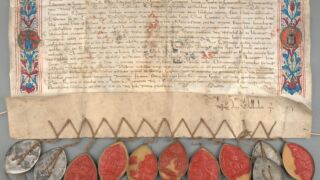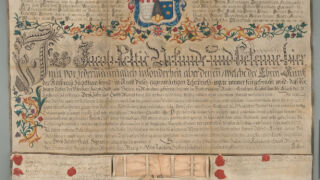Skin and parchment in the history of writing materials
The history of the manufacture and use of parchment as a writing material is closely related to the development of human consciousness and writing culture. Skin, a material of animal origin, has played an extremely important role in the history of humankind. The animal skins have been used for thousands of years for very different purposes: as building materials, clothing, household items, jewelry, musical instruments, tools, ritual items, writing material, and much more. As the skills for processing skills developed, the range of uses for the skins expanded. Those who skinned, processed and tanned the skins have been respected and socially recognized masters in various civilizations. Thus, the tanning of skins is considered to be the first industrial manufacturing process in human history. The wide range of uses for skins was based on the following:
- Skins were sheet material with large surfaces; in the case of large animals, the area could amount to several square meters;
- The skins, which have a fibrous structure, become more flexible and physically stronger once they are processed;
- Skins provide good insulation against the cold and the wind;
- The durability of processed skins in improved by water, which enables skins to be used for the manufacture of watercraft and water containers;
- Material of various thicknesses, degrees of flexibility, surface characteristics and colors can be produced by processing.
The skills for skin processing developed over centuries. The first descriptions of skin tanning methods using animal (marrow, brains and other fat tissue) and plant (leaves, roots, bark) tanning agents date back to the civilizations of Babylon and Egypt in 2000 to 1600 BC. Since that time, skin tanning skills have slowly, but surely, improved throughout the centuries. The processing of skins was perfected by the Greco-Roman period, ca the 2nd century BC. At that time, vegetable tanning was used. The fundamental skin processing methods acquired by that time, continued to be used for centuries. Great technological changes did not start to occur until the late 18th and early 19th centuries.
The use of processed skins as writing materials dates back to the Fourth Dynasty of ancient Egypt in the years 2550 to 2450 BC. And the oldest surviving fragments of texts on skin scrolls dates back to this era. The fragments of skin scrolls with texts that are preserved in the Egyptian and British Museums date back to the Twelfth Dynasty in the years 1990 to 1777 BC.
These finds are also rare because, during that period, skins were not generally used as writing material in Egypt. The main writing material was papyrus. The oldest papyrus scrolls with texts from this region are dated ca 2400 BC and the most recent find from 1082. Papyrus experienced its greatest popularity between 400 BC and the 6th century. During this period the use of papyrus spread from Egypt to the Greco-Roman areas. In Europe, papyrus was replaced as a writing material by parchment during the 200s BC and by paper in the 12th century.
Unlike the Egyptian region, where the main writing material was papyrus since it was readily available as raw material, skin became the main writing material alongside papyrus in the other Middle Eastern areas (Syria, Persia), the Greco-Roman areas and Palestine. This continued until the massive manufacture of parchment started in the 2nd century BC. The Babylonians and Assyrians also used skins (along with clay tablets).
The oldest surviving texts that describe the processing of ox hides come from Egypt and the late Sumerian civilization. Flour, beer, wine, acorns, ox fat, and slaked lime was used as the tanning agent for processing ox hides. The second text from this period describes the tanning of goat skin, in which case goat’s milk, flour, oil, goat fat, slaked lime, grape juice and gallnuts.
However, the improvement of skin processing skills did not eliminate the shortcomings that appearing when writing on the skins. The most significant shortcoming of skins as a writing material was that, when the skin dried, it shrank, and wrinkles developed on the surface. The text either peeled off with the coating layer or became difficult to read on the shrunken and wrinkled surface of the skin. A great development in the processing of skins as writing material occurred during the Greco-Roman Hellenistic period in the 4th century BC. The changes were related to the rapid developments in culture and science in this period.
A synthesis of various cultures – of the Greek, Near Eastern, and some Middle Eastern peoples – occurred on a relatively large territory. This was a mixed culture, the common basis of which was the cultural of the Classical Greece period. Hellenism was the time era for systematizing the knowledge that have been collected in the region through the centuries. All this resulted in the high-level development of culture in several fields of activity, including philosophy, medicine, astronomy, mathematics, etc. During this period, science started to separate itself from philosophy and become an independent field. Scientists like Euclid, Archimedes and others appeared. Rapid technological development occurred. (Maailma ajalugu, 2015. Editor Seppo Zetterberg.)
Scientific centers and libraries developed in the capital of the Hellenistic kingdoms. The most important cultural and scientific centers were in Alexandria, Egypt and in Antioch on the Orontes. Literary and scientific texts became longer and more complicated and the need developed for a good, thin, smooth-surfaced writing materials that could be rolled up.
The economic growth resulted in increased military and political power. However, this economic development in the Hellenistic states during the 3rd century BC was short-lived, and was soon replaced by an increasingly worsening political and economic crisis.
At the same time that the Hellenistic states were suffering a decline, their western and eastern neighbors – Rome in Italy and the Parthian despots in Iran – were becoming more powerful. A period of wars (Macedonian Wars) and conflicts between rulers began.
In 146 BC, the Roman destroyed Corinth, the largest city of the Achaean League. This was also considered to be the year when Greece lost its independence and came under Roman rule. In the 1st century, the Romans also conquered Syria and Egypt. The annexation of Egypt by Rome in 30 BC marks the end of the Hellenistic period.
According to the writings of Marcus Terentius Varro (116–27 BC), an ancient Roman scholar and writer, (see Pliny, Natural History, Book XIII, passage XXI) the rivalry between King Ptolemy of Egypt and King Eumenes II of Pergamon (197–158 BC) resulted in King Ptolemy prohibiting the export of papyrus to Pergamon when the expansion of the Pergamon Library was undertaken, a large amounts of papyrus needed to be purchased from Egypt. Thus, the people of Pergamon were forced to continue the use of skins as writing material. The situation resulted in need to improve the processing of skins. And, during this period, a new method of skin processing, which significantly improved the properties of skin as a writing material, started to be used in Pergamon on a large scale. Until that time, vegetable-tanned skins had been used for writing. But now, with the new processing method, the skins were processed without tanning them. The careful selection of skins before processing and precise observance of the rules and procedures during each stage of the processing ensured the quality of the writing material. The repeated use of slaked lime (before and after the removal of the hair) was important. This was followed by careful washing to remove all the manufacturing residue. The subsequent repeated scrapping of both sides of the skin was necessary to make it thinner and more uniform.
In addition to scrapping, splitting was also used to thin the skins and remove the coating layer. The wet skin was attached to a drying frame, which also functioned as a stretching frame. While drying, the skin continued to be thinned, while also constantly tautening it. The longer the stretching took, and the more uniformly that the skin was tautened from the edges, the more uniform and high-quality the result would be. Before it was completely dry, chalk and pumice powder were rubbed into the damp surface, in order to make it smoother and for the ink to bind better.
These processed skins were named after the Pergamon city-state (today Bergama, Turkey) where they were manufactured. In Greek and Latin, the direct translation of parchment is ‘comes from Pergamon’.
The technology produced very good results. The uniformly thin and flexible parchment was easy to roll and the processing of both sides enabled texts to be written on both the front and the back (recto and verso) (http://en.wikipedia.org/wiki/Codex). This significantly increased the advantages of parchment over papyrus and, starting in the 3rd century, made the former into the main writing material of Europe.
On parchment, the texts could be scraped off and corrected and the parchment sheets with texts on both sides could be bound, which was also a great advantage compared to papyrus. Not less important was the fact that parchment could be used a writing material in regions where papyrus did not grow.
Processed fragments of camel skin that resemble parchment that date from the 8th century BC and have been discovered in the Hebron region (today’s Jordan) prove that attempts to manufacture parchment from raw skins were not only made in Pergamon. However, it is thought that Pergamon was definite the place that deserves the honor and fame of massively producing and utilizing high-quality parchment.
Lad memranae, the original Latin name of processed skin, was later replaced by repyapsivi, charta (thin sheet) or pergamena. The English word parchment, French parchemin and Estonian pärgament are all derived from this.
Vellum has also been used as a synonym for parchment. Initially, the word vellum was used to describe parchment that had been made from the skin of an unborn or newborn calf or lamb. Later, the definition broadened and vellum came to mean high-quality, calfskin parchment, both sides of which had been treated. As a rule, vellum was thinner than ordinary parchment. Vellum was the main material used in producing early (2th to 12th century) handwritten volumes (codices).
For almost 400 years, parchment was formatted as writing material in both scrolls and bound codices. Starting already in the 6th century, a constantly increasing demand for writing materials caused a decline in the quality of parchment production.
Starting in the 4th century, codices, or bound books with handwritten texts in the modern sense, started to become the dominant format. Changes in the book form throughout history have been caused both by the development of human consciousness and that of writing materials.
In the most general sense, books have been seen in human history as a form intended for the public use of written or printed texts of considerable length, which are produced on materials that are sufficient lightweight and strong to ensure the texts are portable and can be handled. The most important task of a book, as a form of text presentation, has been the exchange of information between people. Through time, books have been an interpersonal means of communication (14.10.2017). And the Babylonians’ clay tablets, Egyptians papyrus scrolls, parchment codices, bound paper texts, e-books and other means of presenting texts can all be treated in the history of humankind as various forms of books. In this context, the introduction of parchment as a writing material has played an extremely important role in the history of the development of books as a form: from scroll to binding (as a book).
After the 12th century, when parchment was used alongside paper, parchment maintained its reputation as a rare and durable material. Thus, thin and flexible parchment became an important fashion trend for the production of handwritten, richly decorate volumes decorated with gold and silver. The trend continued throughout the Middle Ages, as well as later, after the art of printing had been invented. As late as the 16th century, important and richly illustrated books were printed on parchment. And often there was a need to invent new treatments. Thus, in 1780, Edwards of Halifax patented the technology for producing transparent parchment. The transparency was achieved not only by stretching and scraping, but by treated the underside with potassium carbonate (KCO3).
By the 16th century, paper was the most popular material in Europe (Bo Rudin, Making Paper. Sweden, 1991) for formatting documents, but the skill of making parchment and its reputation for long-term durability guaranteed its popularity for formatting important documents for centuries. And parchment is still used and manufactured by modern means today.





